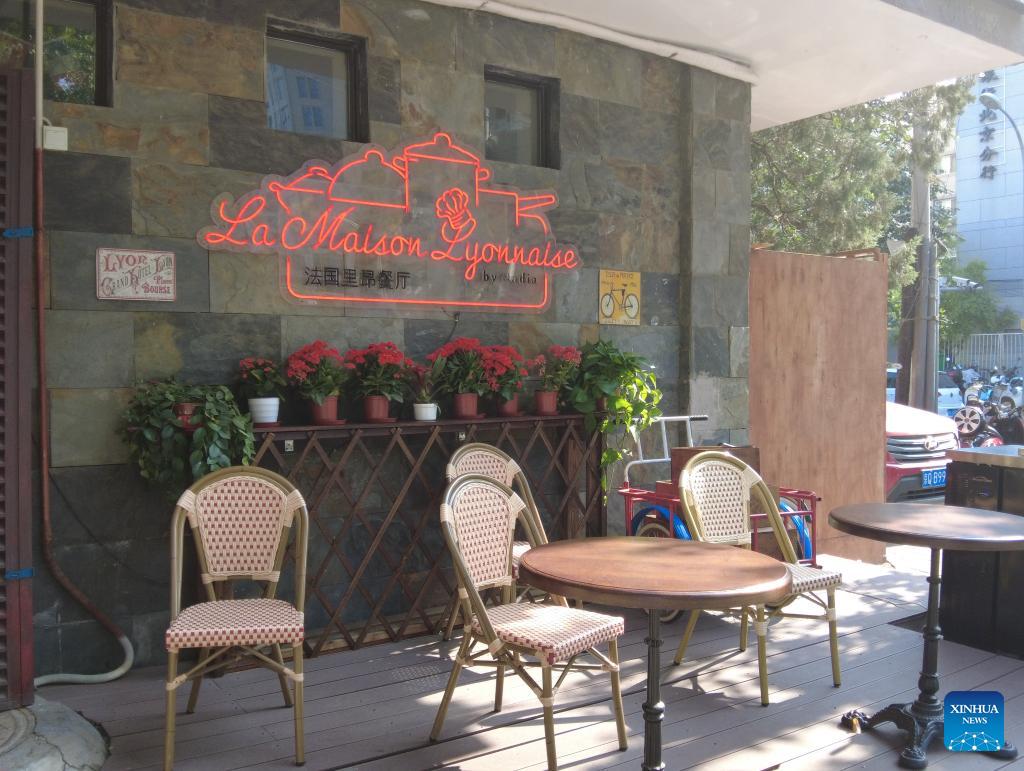
This photo taken on May 20, 2024 shows a French classic dish parsley-buttered snails at the diner "La Maison Lyonnaise" in Beijing, capital of China. (Xinhua/Wang Yue)
by Xinhua writer Ding Yinghua
BEIJING, May 31 (Xinhua) -- I have always fantasized about French cuisine through movies and internet videos, which feature sophisticated dishes served on silver platters by white-gloved waiters. However, whenever I visit a French restaurant, I find myself put off by the pricey menu and aloof service.
Last week, I finally visited a small but atmospheric French diner nestled in downtown Beijing called "La Maison Lyonnaise," and relished the flavors of France for the first time.
Walking into the eatery, the yellow paint, red-and-white-checkered tablecloths and a wall of retro posters immediately made me feel as if I had been invited to a French home. A closer look at the menu revealed a variety of enticing options, all thankfully wallet-friendly.
On the recommendation of the restaurant's manager, Francis Perouse, a native of Lyon, I ordered two classic and popular French dishes: parsley-buttered snails and beef burgundy.
Offered up steaming, the texture of the beef cheek was more tender than I thought, infused with rich flavors from the red wine marinade.
Escargots, or snails, were served in garlic butter with parsley on a platter with rounded indents for each shell. As I steadied a snail with tongs specifically designed to match the shape of the shell in one hand and carefully extracted the inner meat with a fork in the other, the ritual made this dining experience a novel delight.
While enjoying my lunch, I noticed a steady stream of customers filling the restaurant. Being careful not to interrupt, I struck up a quick conversation with a customer named Wang. She told me that she had lived in France and that the food here evoked memories of meandering through the streets of Lyon, satisfying her cravings for French rural delicacies.
According to Perouse, regular French food enthusiasts like Wang are not that common. "Maybe six out of ten people who come to my restaurant for the first time have never eaten French food before."
However, he said that Chinese people are very curious, and that is one of the reasons he opened a diner in China. "They love to try new things and experience new things."
The French restaurant served as a microcosm of the growing appetite of Chinese consumers for French delicacies. In November of last year, China's fresh-food chain Freshippo, my go-to destination for imported food, signed cooperation agreements with seven French enterprises for the imports of agri-food products worth 3 billion yuan (about 422 million U.S. dollars) over three years.
From Bordeaux wines and Comté cheese to Gillardeau oysters and Evian bottled water, I have witnessed many signature French agri-products gaining increasing popularity in Chinese markets.
France is now emerging as China's largest source of agri-food imports and second-largest trading partner of agricultural products in the European Union (EU), according to customs data.
"Due to different natural conditions, the two countries' agricultural production and trade are highly complementary. French wine, dairy products and cereals enjoy high acceptance in the Chinese market," said Guo Ying, a researcher from the Institute of Environment and Sustainable Development in Agriculture.
This year marks the 60th anniversary of the establishment of diplomatic relations between China and France. Following high-level exchanges, the two nations have fostered closer ties in the agricultural sector.
In May, China and France issued a joint statement, pledging that the two countries will work to expand French pork exports to China, and provide guarantees for market access and safety of poultry products. They have also vowed to work to expand cooperation in the wine industry.
Perouse told me that the red wines in his restaurant as well as snails, cheese, oysters and flour are directly imported from France. However, when it came to preparing pan-fried bullfrog and onion soup, they opted for Chinese local products. He explained that the Chinese bullfrog, being larger and meatier, lends itself perfectly to the dish.
Seeing this blend of Chinese and French ingredients in traditional French dishes, I couldn't help but recall the words of EU Commissioner for Agriculture Janusz Wojciechowski from a written response during our interview: "...by bringing together the diverse products of China and the EU, we can create countless combinations of dishes, tastes, and flavors."
In a world threatened by fragmentation due to division and geopolitical disruptions, I see hope in this French restaurant where the East and the West meet elegantly. It's not just about the delicacies but also about curiosity and openness. ■

This photo taken on May 20, 2024 shows an exterior view of the French diner "La Maison Lyonnaise" in Beijing, capital of China. (Xinhua/Wang Yue)



